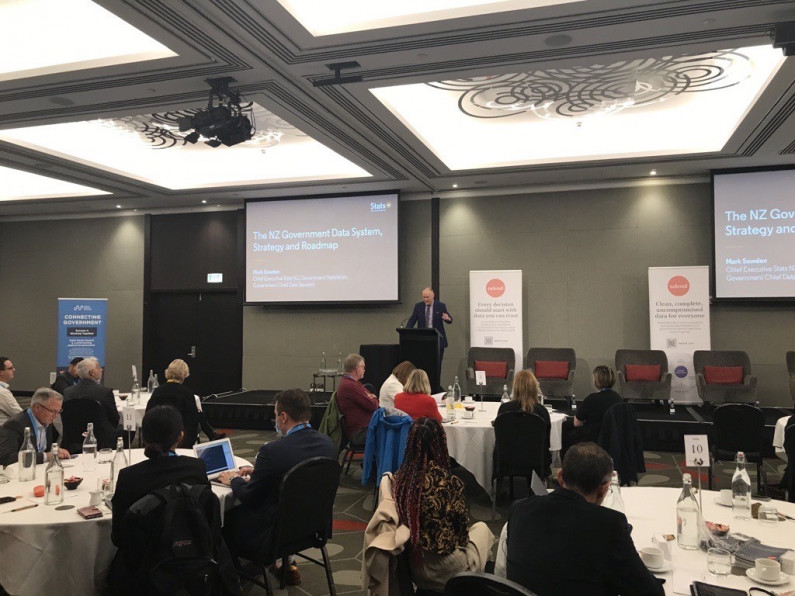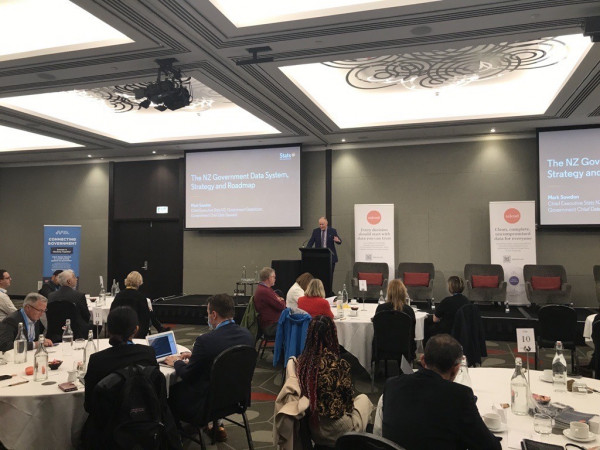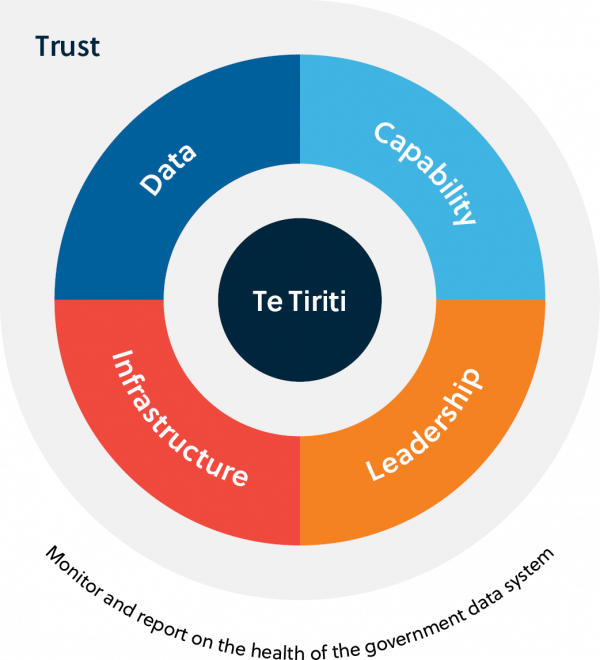
On Tuesday 12 April, I was pleased to speak at the Public Sector Network’s Data & AI Executive Event in my capacity as the Government Chief Data Steward (GCDS) on the Government Data Strategy and Roadmap.
In government we hold huge amounts of data about, and on behalf of, New Zealanders which has the potential to drive innovation and result in numerous benefits for Aotearoa and its people.
With the release of the revised and refreshed Government Data Strategy and Roadmap last year and a raft of initiatives underway across the system, the government data system is well and truly gaining momentum.
But to build on the foundations we’ve laid for a healthy, efficient government data system, we must keep working collectively. Making sure we do is one of my key responsibilities as the GCDS.
I took the opportunity at this event to take stock of where we’ve been, what we’re doing, and the next steps of our journey. I’ve shared these reflections below.

GCDS Mark Sowden presenting to members of the government data system on the Government Data Strategy and Roadmap
In September last year, I released the refreshed Government Data Strategy and Roadmap – a pathway outlining the shared direction and vision for New Zealand’s data system.
Since the first Strategy and Roadmap was published in 2018, events like the pandemic have significantly changed the context in which data is collected, managed and used.
The Strategy and Roadmap guides the data system to work together to be inclusive and integrated. Achieving this requires four fundamental components: data, capability, infrastructure, and leadership. These are the focus areas of the Strategy and Roadmap.
At the heart of these components is a responsibility to uphold the principles of Te Tiriti, and a commitment to build and maintain public trust and confidence in the data system.
Below is a summary of the initiatives delivered under the focus areas so far.

Having the right data at the right time is important, but sometimes that data doesn’t exist or isn’t in a fit state to be utilised by government and needs investment.
Last year, Cabinet endorsed the Data Investment Plan – a targeted 10-year plan to meet the current and future needs of the data system by providing a view of data investment opportunities needed to boost its overall health.
The second iteration of the Plan is set to be provided to Cabinet in July this year, including broader coverage of Māori data needs and recommendations about where to begin with investments so we can achieve the Plan’s long-term priorities.
Open and accessible data is equally important.
In 2017, New Zealand signed up to the Open Data Charter – a collaboration between governments and organisations around the world working to open up data based on a shared set of six principles. This plays a crucial role in fostering trust in the government data system.
As the GCDS, I am responsible for implementing the Charter across government, and work is underway to secure wider contribution from agencies.
Also under the data umbrella is the collection of Māori Descent and Iwi affiliation information through the vaccination programme, led by the Ministry of Health and supported by the Data Iwi Leaders Group and Stats NZ.
The Ministry of Health has worked with Māori groups to create Tātai – a website to collect descent and iwi data linked to the online vaccination booking system.
Tātai is a prime example of how, through effective cross-government cooperation and partnerships with Māori, iwi can have not only the data they need to govern, but the ability to govern their data.
Consistent statistical standards are important for allowing government to share data more effectively, but especially to ensure people in Aotearoa can see themselves reflected in the data the system produces.
Last year a standard for gender, sex and variations of sex characteristics was published and mandated for use, and reviews of ethnicity, Māori descent and iwi affiliation standards are underway.
In 2020 I released the Algorithm Charter for Aotearoa New Zealand – a cross-government commitment to ensure transparency and accountability in agencies’ use of algorithms.
The Charter is an important part of building public trust in the data system and the ways government is using tools like algorithms to make decisions on behalf of New Zealanders.
At the time of its release, the Charter had 21 signatories, which has since risen to 27 – representing more than half of all central government departments including the biggest users of data. It's been impressive to see the genuine impact the Charter has had on agencies’ behaviours – for example, agencies’ move towards publishing their algorithms on their websites.
Last year Stats NZ commissioned an independent review of the Charter to better understand how it was working, and what further support agencies needed. Results of this will be available in the next few months.
Stats NZ has refocussed its capability-building efforts with the data system through the recent formation of an Agency Partnering team.
The goal is for the team to serve as a mechanism for Stats NZ to provide tailored support to the data system that assists agencies with data-related issues of high value to the system.
In recognising that agencies have differing levels of ability to effectively steward the data they hold or us, the Data Maturity Assessment being developed will give a reliable understanding of where support is needed.
Stats NZ is also partnering with iwi and Māori organisations and implementing key initiatives to build Māori Data Capability, including working with Te Hiku o te Ika Development Trust under the Crown Social Development and Wellbeing Accord, and working with Te Tihi o Ruahine under the relationship agreement with Stats NZ.
Our current statistics legislation, the Statistics Act, was well-suited for its time but less equipped for an ever-changing world dominated by technology.
To bring our legislation into the present day and beyond, Stats NZ has developed the Data and Statistics Bill – a modern, flexible, and future-focused Bill that promotes trust and confidence in data and official statistics and in their use by government to make decisions.
The Bill addresses some significant gaps of the Statistics Act, namely the lack of any mention of data and Te Tiriti o Waitangi.
The Data and Statistics Bill passed its first reading at the end of last year and is currently undergoing the Select Committee process, with a report back due in May.
Also happening under the leadership umbrella is Stats NZ’s work to develop a new approach to governance of data that reflects Māori-Crown partnership. The Māori Data Governance co-design process, co-led by the Data Iwi Leaders Group and Stats NZ, has resulted in the formation of the Māori Data Governance Working Group, Ohu Raraunga.
The Māori Data Governance model recognises for some Māori, data is taonga and requires kaitiaki. The purpose of this work is to explore ways for Māori to have greater sovereignty over their data.
There is a broad understanding that data is the engine of the public service’s ability to deliver between outcomes for New Zealanders. However, fragments in the public service system and agencies operating in isolation can hinder this.
The Health of the Data System Report paints a clear picture of system health to capture how well the data system delivering on its two goals of inclusivity and integration.
By recognising data as critical infrastructure we ensure our data system is integrated and inclusive.
The integrated data infrastructure, or the IDI, is a large research database which holds data about everyday New Zealanders and the homes they live in.
These datasets are linked, or integrated, to form the IDI, which can safely be accessed for research and to inform government policy and evaluation.
Agencies across the system are developing the IDI Commons project – a community platform for IDI users to share code, techniques and tips to support collaboration among researchers.
Another joint agency IDI project is underway to develop code modules which bundles all the concepts and code that might be needed to find specific categories of data – for example, ‘people with driver licences’.
These projects will improve the quality of insights coming out of the IDI.
Important work is also happening on system design so that the data system can easily connect and share the volume of data it holds, particularly where it's needed to inform policy and decisions across government. Of course, this must include Te Ao Māori perspectives.
This work is currently underway and is informed by government strategies and the Māori Data Governance model mentioned above.
It’s incredible to think that the many pieces of work outlined here are only the first year of what’s in store for the Strategy and Roadmap.
We are currently reviewing the initiatives set out for year two to ensure it strikes the right balance between being ambitious and being realistic. This means being pragmatic about what the system can deliver while being strategic on where to place our efforts for the most impact.
In the upcoming year, we will:
This programme is bold and ambitious, and it needs to be. There are some big challenges ahead – challenges we can only meet with collective action.
Bringing the Strategy and Roadmap to life must involve a cross-government, cooperative approach.
As the system matures, I’m looking to see other agencies take greater ownership of initiatives under the Strategy and Roadmap and join us in pursuit of our goal to make New Zealand’s data system the best in the world.
While there is already a lot of interest in this work, let’s turn enthusiasm into action. Let’s work in collaboration with each other, with Māori, with experts and interested groups to make the data system of Aotearoa one that not only delivers efficiencies for government, but meaningfully impacts the lives of all New Zealanders.
We’ve done some great work laying the foundations, and now it’s time for the whole system to pick up the tools.
